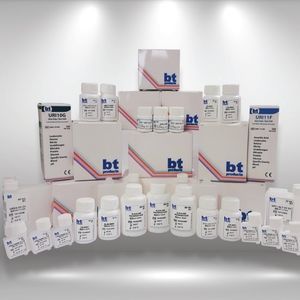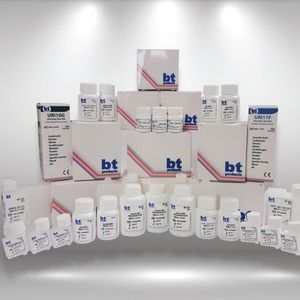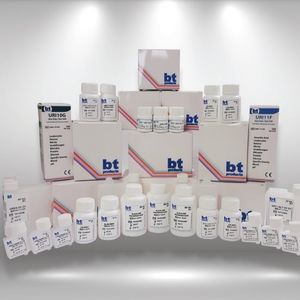
- Laboratory
- Laboratory medicine
- Urinalysis test strip
- BILIMSEL TIBBI ÜRÜNLER
Urinalysis test strip URI10GpHproteinglucose
Add to favorites
Compare this product
Characteristics
- Application field
- for urinalysis
- Tested parameter
- pH, protein, glucose, nitrite, bilirubin, specific gravity
- Sample type
- urine, blood
Description
URI10G urine reagent strips provide tests for the semi-quantitative measurement of leukocytes, ketone, nitrite, urobilinogen, bilirubin, protein, glucose, specific gravity, blood and pH in urine. For use with the urine analyzer of BT URI500B, BT URI50 . The test is intended for use by health care professionals.
SUMMARY
URI10G urine reagent strips consist of a plastic strip affixed with reagent papers and a calibration pad. This feature facilitates measurement of multiple urine constituents and use for everyday diagnosis and group examinations. The calibration pad, which is not impregnated with reagents, allows instrumental correction interference from natural color of urine automatically and obtains accurate result.
TEST PRINCIPLES AND LIMITATIONS
Leukocytes: The test reveals the presence of granulocyte esterases. These esterases cleave an indoxyl ester, and the indoxyl so liberated reacts with a diazonium salt to produce a violet dye. Leukocyte esterase results may be positive in the absence of observable cells if the leukocytes have lysed. Positive results may occasionally be found with random specimens from females due to contamination of the specimen by vaginal discharge. Elevated glucose concentrations (55 mmol/L-110 mmol/L) or high specific gravity may cause decreased test results. The presence of cephalexin, cephalothin, tetracycline may cause decreased reactivity, and high levels of the drug may cause a false negative reaction. The test area does not react with lymphocyte. Reactivity may also vary with temperature
Ketone: This test is based on the principle of Legal’s test and is more sensitive to acetoacetic acid than to acetone.
Catalogs
No catalogs are available for this product.
See all of BILIMSEL TIBBI ÜRÜNLER‘s catalogsOther BILIMSEL TIBBI ÜRÜNLER products
Urinalysis Strip, Sheath, Reagents
Related Searches
- Solution reagent kit
- Protein reagent kit
- Diagnostic reagent kit
- Laboratory reagent kit
- Enzyme reagent kit
- Histology reagent kit
- Dye reagent
- Antibody
- Buffer solution reagent kit
- Clinical chemistry reagent
- Clinical chemistry analyzer
- Quality control reagent kit
- Clinical reagent kit
- Virus reagent kit
- Automatic clinical chemistry analyzer
- Benchtop clinical chemistry analyzer
- Test strip
- Tissue reagent kit
- Electrolyte reagent kit
- Colorimetric reagent kit
*Prices are pre-tax. They exclude delivery charges and customs duties and do not include additional charges for installation or activation options. Prices are indicative only and may vary by country, with changes to the cost of raw materials and exchange rates.












